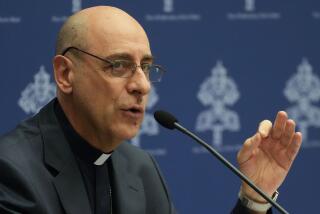A Modest Proposal to Temper Temptation
- Share via
Part of the problem with priestly pedophilia, says Vatican spokesman Cardinal Dario Castrillon Hoyos, is the current “environment of pansexuality.”
Now there’s a word to look up. According to Merriam-Webster, it means “exhibiting or implying many forms of sexual expression.” That sounds like a pretty good description of today’s culture. Of course, “society made me do it” is not an excuse for having sex with children.
But if even the Catholic Church--which normally prides itself on fidelity to time-honored values--is searching for new explanations for its sexual problems, then maybe it’s time to look to an old solution.
Pansexuality, of course, is not new.
In ancient Babylon, it was the religion. Herodotus, the first historian, wrote that in 5th century BC Mesopotamia, “every woman born in the country must once in her life go and sit down in the temple of love, and there consort with a stranger.” According to ritual, the woman “goes with the first man who throws her money, and rejects no one. When she has gone with him, and so satisfied the goddess, she returns home.”
Herodotus adds that “a custom very much like this is found also in certain parts of the island of Cyprus.”
Such customs no doubt have their appeal to some, but it’s difficult to imagine a stable society being built around institutionalized debauchery.
Indeed, Christianity represented a backlash against pagan pansexuality. Jesus lived a celibate life, and he was born of a virgin mother. As he preaches in Luke, there is no marriage in heaven. And since the early Christians, notably St. Paul, believed that the second coming of Christ was nigh, celibacy was much praised all through the New Testament.
Yet as Christianity matured, an older biblical injunction--”be fruitful and multiply”--reasserted itself.
One of the problems the medieval church faced was that the fruit of priestly loins was multiplying too much. Clerical children were secularizing church lands through inheritance.
That concern helped push the 11th century church back toward celibacy.
At about that time, the Eastern Orthodox church broke off, developing a two-tier system, allowing priests to marry while reserving celibacy for bishops.
The notion that higher orders of people would be celibate is a consistent theme through most philosophies. As Aristotle said, we most admire that which is hard to do.
Yet to be admirable, celibacy must be sustainable. And yet if pansexuality is so rampant that even Catholic priests are led into temptation, then something has to change.
So here’s a modest proposal. Bring back the one tried-and-true guarantee of celibacy: castration.
The practice was once common--and not just for harem-keepers and choirboys--because it reliably helped men focus on their mission, whatever that might be.
Today, modern medicine offers castration through chemistry, and that condition, unlike surgery, is reversible.
While the modern mind might find even voluntary, temporary castration to be repulsive, surely pedophilia is more repulsive. And if, as Cardinal Castrillon said, we live in a pansexual world in which the erotic is expressed in everything, then perhaps those wondering how to safeguard children might look to the wisdom of the ages for an answer.
One thing is for sure: Given the immensity of this scandal, mere assurances that the old “honor system” of celibacy can be made to work again will not be acceptable. If the church wishes to regain its position of trust, it might consider what it is willing to give up.
More to Read
Sign up for Essential California
The most important California stories and recommendations in your inbox every morning.
You may occasionally receive promotional content from the Los Angeles Times.













